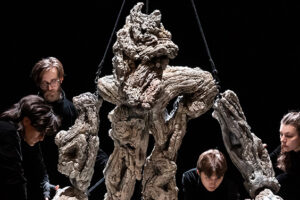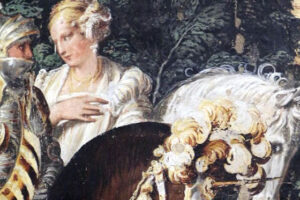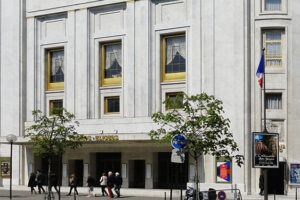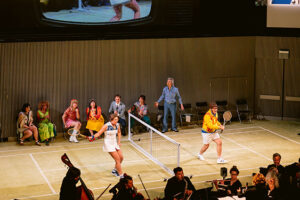
The famous (or infamous) “rat Lohengrin” is now available both on DVD
and Blu-ray
. This Hans Neuenfels staging for the Bayreuth Festival caused quite a stir at its 2010 premiere, but now, with time and distance, how radical is the production?
In a nutshell, Neuenfels’ vision of Lohengrin is that the entire opera is a scientific experiment. Reinhard von der Thannen‘s designs set the opera in a sterile laboratory-like room that resembles Skinner’s box. In the prologue, there is a surprisingly touching animated cartoon of a bunch of rats, including a pink rat, running towards a mysterious destination. They seem alternately lost and confused. (Throughout the opera, the screen is used for intermittent video projections, including one that shows the rats springing from Telramund’s brain.)
The curtain then goes up on a laboratory setting, where Lohengrin (Klaus Florian Vogt) is pushing against a doorway. He finally manages to push the doors open, enters the mysterious laboratory, and the opera proper starts.
Brabant is home to a massively brainwashed populace, so robbed of their humanity that they are quite literally lab rats. They even have numbers branded into their backs. There are black rats, pink rats, white rats, but they all act like creatures robbed of any individuality. Only the main characters take on human form. King Henry (Georg Zeppenfeld) is a weak leader who wears a flimsy-looking felt black felt crown, in contrast to Telramund (Jukka Rasilainen), the real man in charge, regal in a shiny silver suit.
Elsa makes her entrance with a bunch of arrows in her front and back, I suppose to demonstrate the slingshots she’s had to endure to her character, but also to make the connection that Elsa, too, is not quite human. Elsa throughout the opera is somewhere between animal and swan. (Her wedding gown is decorated with large swan feathers.) She can be hunted but she is unreachable.
At the end of the wedding in Act Two she falls down, like a stun-gunned animal, but in Act Three, she cowers in fear of Lohengrin. She is still half-human, half-bird, some creature that can’t quite be captured or owned completely. (For ballet lovers, the idea of a man trying to own and capture a bird-woman will be a familiar trope—both Swan Lake and The Firebird use this theme.)
Lohengrin makes his entrance with the lab rats carrying a huge stuffed swan. There’s a surreal, not-quite-human quality to Lohengrin from the start. Of course that is already written into the libretto, but in this production, he seems almost like a genetically engineered wizard. As he appears, the lab rats become human. But the ultimate “experiment” is whether he can connect with Elsa and forge a real human bond, and the answer is definitely “no.” Their relationship throughout the opera is marked by fear and physical distance. The wedding night is an intense scene as Elsa fights off Lohengrin and cowers in a corner. They cannot connect on any level.
For the final scene, the rats take off their costumes and look like soldiers. Lohengrin wheels in a dead rat on a bed and rips off the mask to reveal Telramund underneath. But Lohengrin’s ability to turn rats into humans does not extend to the transformation of the soul.
The creepiest moment of the production is Lohengrin’s big reveal of Elsa’s brother Gottfried: a test-tube baby that crawls out of his egg and severs his own umbilical cord. This latest version of laboratory-created “human,” Lohengrin indicates, will be our new “Führer”—though that poisonous word is omitted from the libretto as performed here.
Neuenfels’ production, in other words, makes Lohengrin a study of the intangible quality that we define as “humanity,” and also the limits of science. The message (or at least my interpretation) is that you can look like a rat, or you can look like a person, but it matters not if underneath, there is no soul. Lohengrin is handsome and charismatic, but soulless. He looks like a matinee idol, but beneath the good looks there’s a creepy emptiness to him. Though he is capable of changing the rats into a human form, he can’t really humanize them. They remain brainwashed automatons. With Elsa, a more complex experiment, Lohengrin suffers his most miserable failure.
The cast is a mixed bag. Vogt’s Lohengrin is already available in Nikolaus Lehnhoff‘s 2006 production. The voice is light, bright, and lyrical, sort of a Mozart tenor singing Wagner. Ordinarily I’d say I prefer a richer timbre for Lohengrin, but Vogt’s voice is slightly disembodied and angelic sounding, especially in Wagner, and it fits this production very well. He makes Lohengrin just the right mixture of lab robot and human.
Rasilainen’s voice has a marked beat on sustained notes that is not very pleasant on the ears, but he does radiate a thuggish authority as Telramund. Both Zeppenfeld as King Henry and Samuel Youn as the King’s Herald were excellent: clear, resonant voices with almost none of the Bayreuth bark. I had never heard of these singers before—now I will be on the lookout.
The performance’s main caveat is Annette Dasch as Elsa. Her voice is thin, fluttery, scratchy, completely at odds with Wagner’s rich, surreal orchestration. It’s as if Despina wandered into Brabant—she wasn’t so much Elsa as Elsinetta. I found her very difficult to listen to for an extended period of time. “Elsa’s Dream” became a nightmarish assault on the eardrums. Surely there must have been better singers availabe? If there is one reason not get this video, it would be Dasch’s singing.
On the other hand, Petra Lang‘s mezzo handles Ortrud’s upwards lunges to the top notes fairly well. This music is always a fine balance between “shrieking” and “thrilling” and Lang handles that balance as well as any. She’s dressed just like Telramund, in a shiny suit, but in the long second act she and Telramund start pawing at each other like animals, and she finsihes her scena with a huge kiss. Very Lady Macbeth-like!
The real stars of this performance were the magnificent Bayreuth Chorus and Orchestra, under the leadership of Andris Nelsons. The strings shimmered, the brass blared, it is basically the ideal Wagner orchestra sound. It was wonderful to hear the famous “Bayreuth sound” actually audible on the recording—the chorus really seems to echo and resonate across the deep stage.
The video is a departure from the old Bayreuth videos, which were filmed “non-live” with dress rehearsal footage. It’s taken from a live performance, and there are clamorous ovations during the curtain calls for the principals, although the director is conspicuous in his absence. Whether you would want this Lohengrin in your video library depends on personal taste. It’s an opera with an unusually complete discography—both live and studio recordings in excellent sound where the musical performances are on a much stronger level than this video.
The main reason to get this video is if one is open to experimental opera productions. And yes, this is an “experimental opera production”—not “Eurotrash.” There may be no breastplates and swan boats, but it’s clear that Neuenfels has treated the work with thought, care, and consideration. His vision of the work is consistently applied across the entire opera, and the production has clarity, logic, and yes, humanity. It’s not your grandfather’s Lohengrin, but it is a haunting and disturbing rethinking of Wagner’s opera.

























Comments